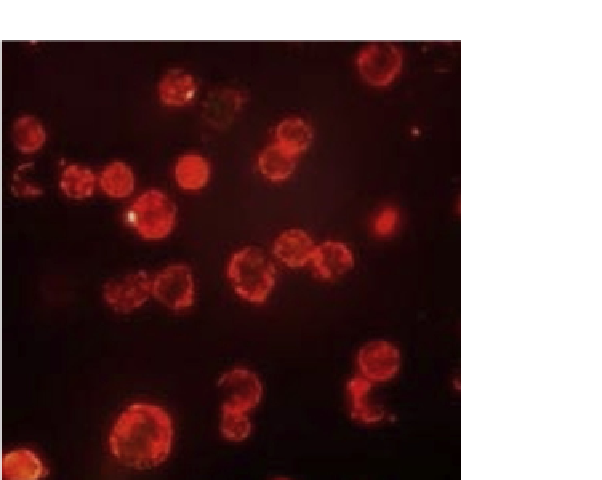Biomedical Engineering Reference
In-Depth Information
FIGURE 8.3
Breast cancer cell line SK-BR3 after exposure to QDs.
Courtesy of Ocean NanoTech.
(For color version of this figure, the reader is referred to the online version of this topic)
conducted to evaluate the toxicity of QDs.
123,124
One study had shown that sur-
face oxidation of QDs led to the reduction of Cd on the QD surface causing the
release of free cadmium ions in solution causing cell death.
125
Another study
showed that toxicity was caused by the nanocrystalline particles and by the mol-
ecules covering the surface of the QD molecules.
126
In addition to the release of
Cd
2+
ions from the surface of QDs, it was also reported that the precipitation of
QDs on the cell surface impaired the cell growth.
127
When the QDs were only
found in the medium surrounding the cells, they were less toxic than when the
QDs were taken up by the cells.
127
Various cell lines were used in the toxicity evaluation of CdTe, CdTe/CdS
core-shell structured and CdTe/CdS/ZnS core-shell-shell structured QDs.
128
The results indicated high toxicity of the QDs to the various cell lines studied
which was diminished with epitaxial growth of a CdS layer that reduced the
release of Cd
2+
ions. In addition, building a ZnS shell around the CdS or CdTe
layer effectively prevented the Cd
2+
release that essentially made the QDs com-
patible to cells.
128
In vivo studies indicated that the water-soluble QDs initially
accumulated in liver after 0.5-4 h post-injection and absorbed by the kidney at
15-80 days in the blood.
129
The studies also showed that the biodistribution of
aqueous QDs was size-dependent.
To evaluate the toxic effects of QDs on cells in vitro, direct counting of cell
HEK293 population was used 3 days after treatment with CdTe QDs at various
concentrations. The results indicated that the growth curve of HEK293 cells
treated with 37.5 nM CdTe QDs was not significantly altered as compared to
that of the control but 300 or 600 nM CdTe QDs nearly completely inhibited
cell growth.

